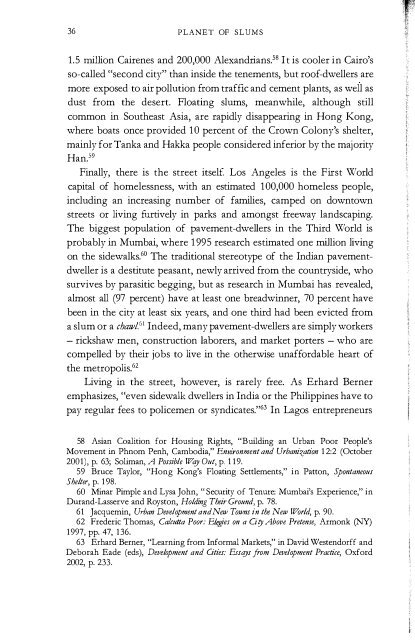Untitled - Rebel Studies Library
Untitled - Rebel Studies Library
Untitled - Rebel Studies Library
You also want an ePaper? Increase the reach of your titles
YUMPU automatically turns print PDFs into web optimized ePapers that Google loves.
36 PLANET OF SLUMS<br />
1.5 million Cairenes and 200,000 Alexandrians.58 It is cooler in Cairo's<br />
so-called "second city" than inside the tenements, but roof-dwellers are<br />
more exposed to air pollution from traffic and cement plants, as well as<br />
dust from the desert. Floating slums, meanwhile, although still<br />
common in Southeast Asia, are rapidly disappearing in Hong Kong,<br />
where boats once provided 10 percent of the Crown Colony's shelter,<br />
mainly for Tanka and Hakka people considered inferior by the majority<br />
Han.59<br />
Finally, there is the street itself Los Angeles is the First World<br />
capital of homelessness, with an estimated 100,000 homeless people,<br />
including an increasing number of families, camped on downtown<br />
streets or living furtively in parks and amongst freeway landscaping.<br />
The biggest population of pavement-dwellers in the Third World is<br />
probably in Mumbai, where 1995 research estimated one million living<br />
on the sidewalks.60 The traditional stereotype of the Indian pavementdweller<br />
is a destitute peasant, newly arrived from the countryside, who<br />
survives by parasitic begging, but as research in Mumbai has revealed,<br />
almost all (97 percent) have at least one breadwinner, 70 percent have<br />
been in the city at least six years, and one third had been evicted from<br />
a slum or a chawl'"! Indeed, many pavement-dwellers are simply workers<br />
- rickshaw men, construction laborers, and market porters - who are<br />
compelled by their jobs to live in the otherwise unaffordable heart of<br />
the metropolis.62<br />
Living in the street, however, is rarely free. As Erhard Berner<br />
emphasizes, "even sidewalk dwellers in India or the Philippines have to<br />
pay regular fees to policemen or syndicates."63 In Lagos entrepreneurs<br />
58 Asian Coalition for Housing Rights, "Building an Urban Poor People's<br />
Movement in Phnom Penh, Cambodia," Environment and Urbanization 12:2 (October<br />
2001), p. 63; Soliman, A Possible Wqy Out, p. 119.<br />
59 Bruce Taylor, "Hong Kong's Floating Settlements," in Patton, Spontaneous<br />
Shelter, p. 198.<br />
60 Minar Pimple and Lysa John, "Security of Tenure: Mumbai's Experience," in<br />
Durand-Lasserve and Royston, Holding Their Ground, p. 78.<br />
61 Jacquemin, Urban Development and New Towns in the New World, p. 90.<br />
62 Frederic Thomas, Calcutta Poor: Elegies on a City Above Pretense, Armonk (NY)<br />
1997, pp. 47, 136.<br />
63 Erhard Berner, "Learning from Informal Markets," in David Westendorff and<br />
Deborah Eade (eds), Development and Cities: Essqys from Development Practice, Oxford<br />
2002, p. 233.<br />
THE PREVALENCE OF SLUMS 37<br />
rent out wheelbarrows, borrowed from construction sites, as ersatz<br />
beds for the homeless.64<br />
2. Pirate Urbanization<br />
The majority of the world's urban poor no longer live in inner cities.<br />
Since 1970 the larger share of world urban population growth has been<br />
absorbed by slum communities on the periphery of Third World cities.<br />
Sprawl has long ceased to be a distinctively North American phenomenon,<br />
if it ever was. The "horizontalization" of poor cities is often as<br />
astonishing as their population growth: Khartoum in 1988, for<br />
example, was 48 times larger in developed area than in 1955.65 Indeed,<br />
the suburban zones of many poor cities are now so vast as to suggest<br />
the need to rethink peripherality. In Lusaka, for example, the outlying<br />
shantytowns house two thirds of the city's population - leading one<br />
writer to suggest that "these compounds are called 'peri-urban' but in<br />
reality it is the city proper that is peripheral."66 The Turkish sociologist<br />
C;:aglar Keyder makes a similar point about the gecekondus that surround<br />
Istanbul: "In fact, it would not be too inaccurate to think of Istanbul<br />
as a conglomerate of such gecekondu districts with limited organic unity.<br />
As new gecekondu areas are added - inevitably to the outer perimeters -<br />
more nodes are strung on the web in a serial manner."67<br />
In the sprawling cities of the Third World, then, "periphery" is a<br />
highly relative, time-specific term: today's urban edge, abutting fields,<br />
forest, or desert, may tomorrow become part of a dense metropolitan<br />
core. With the exception of East Asia, where there are significant<br />
inventories of peripheral state-built housing (like Beijing's older industrial<br />
suburbs of Shijingshan, Fengtai, and Changxiandian), edge<br />
development in Third World urban areas takes two principal forms:<br />
squatter settlements and - to use the evocative Colombian term -<br />
64 Amy Otchet, "Lagos: The Survival of the Determined." UNESCO Coune/; 1999.<br />
65 Galal Eldin Eltayeb, "Khartoum, Sudan," UN-HABITAT Case <strong>Studies</strong>,<br />
London 2003, p. 2.<br />
66 Sivaramakrishnan, "Urban Governance," in Cohen, Prepanng for the Urban<br />
Future, p. 229.<br />
67 C;:aglar Keyder, "The Housing Market from Informal to Global," in Keyder<br />
(ed.), IstanbuL' Between the Global and the Local, Lanham (Md.) 1999, p. 149.


